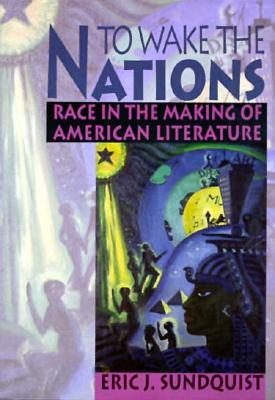Editor's Note
Welcome back to school! This September, I’m revisiting four foundational works that shape my understanding of American intellectual history. Join in the comments, and share your finds.

“After ‘Invisible Man’ by Ralph Ellison, the Prologue,” Jeff Wall (2000, MOMA)
How do our notions of what belongs in “the” American literary canon expose cultural attitudes toward race? Eric J. Sundquist explores this dilemma by joining disparate fields of scholarship on black and white literary cultures in To Wake the Nations: Race in the Making of American Literature (Cambridge and London: The Belknap Press of Harvard University Press, 1993). There, he intertwines traditions that are too often segregated in critical review. This was one of the most useful books that I read in graduate school for content and method, so it’s worth a revisit.
In order to “trace the expressive heritage of a biracial culture” from 1830 to 1930, Sundquist proposes an ambitious “new genealogy of American authorship” that restores the major works of black writers and juxtaposes them with the less-celebrated works of white writers. His study has an important intellectual heritage of its own. He builds on two works, both released in 1941, that have become standard (but separate) texts for American studies scholars: F. O. Matthiessen’s American Renaissance: Art and Expression in the Age of Emerson and Whitman (London: Oxford University Press) and editor Sterling A. Brown’s The Negro Caravan: Writings by American Negroes (New York: Citadel Press). Sundquist offers a provocative sequel to both, with a methodology that blends the vantage points of black and white authors without forcing a new union or reifying old categories. It’s an exercise in critical balance.
Over the course of 700-plus pages, Sundquist argues that “black” and “white” texts must be reconsidered together as a “single tradition” of cultural expression. He imagines an American literary canon inspired by W. E. B. Du Bois’ directive “that the African American had every right to be recognized as a ‘co-worker in the kingdom of culture.’” Sundquist’s American kingdom of culture is a busy, messy factory where ideas on race are constantly in exchange. Some of his interpreters (Herman Melville
, Frederick Douglass, Mark Twain) may be more familiar than others (Charles Chestnutt). But Sundquist is not interested in delving into white texts’ exclusion of blacks or black texts’ exploration of racial experience. Instead, his “concern is less to demonstrate that My Bondage and My Freedom is as indisputably ‘classic’ as Moby-Dick or Walden than to demonstrate that our terminology, our methods of analysis and judgment, and our very capacity to formulate the notion of the literary classic can be productively reconstructed.” Through his choice of case studies, Sundquist raises questions about why authors have generated or sustained certain concepts of race in literature. And he wonders how a new canon might shift around our analysis.
If you’re interested in the links between novels and intellectual history, To Wake the Nations is a good place to start. Sundquist’s approach of pairing texts grants greater narrative leverage in tracing literature’s hybrid manufacture. In each work, he perceives “critical languages” that support his three major arguments on the cultural alignment of liberty and slavery, the creation of the national “color line,” and the use of “Africanisms” in American literature. The first part, “Slavery, Revolution, Renaissance,” paints Melville’s Benito Cereno as a portrait of an “interrupted revolution.” The slave ship functions as a floating New World where the past, present, and future of human slavery are conflated for moral examination. Sundquist adds historic gloss by making links to the Haitian Revolution and the Amistad mutiny. Our perspective widens to see how early American writers used slavery as a metaphor for empire.
 Painstakingly, Sundquist reconstructs the environmental impact of racial attitudes on black and white authors alike. “The renaissance of American literature,” he writes, “occurred in an era in which the authority of the Revolution had become the subject of anxious meditation and in which the national crisis over slavery’s limits everywhere compelled a return to the fraternally divisive energies of the revolutionary generation.” Slave resistance in the global South gave white and black writers a moral language to discuss empire’s heavy cost. By invoking the iconography of the Haitian Revolution, authors could “lay bare the paradoxical way in which slavery and revolution were linked throughout antebellum history, dark twins of a national ideology riddled with ambiguity and tension,” Sundquist writes. It is a churning renaissance that we do not see in Matthiessen’s work: all the politics of bondage knotted up in nostalgia. Melville’s American Revolution lies frozen in a parody of liberty, ever incomplete.
Painstakingly, Sundquist reconstructs the environmental impact of racial attitudes on black and white authors alike. “The renaissance of American literature,” he writes, “occurred in an era in which the authority of the Revolution had become the subject of anxious meditation and in which the national crisis over slavery’s limits everywhere compelled a return to the fraternally divisive energies of the revolutionary generation.” Slave resistance in the global South gave white and black writers a moral language to discuss empire’s heavy cost. By invoking the iconography of the Haitian Revolution, authors could “lay bare the paradoxical way in which slavery and revolution were linked throughout antebellum history, dark twins of a national ideology riddled with ambiguity and tension,” Sundquist writes. It is a churning renaissance that we do not see in Matthiessen’s work: all the politics of bondage knotted up in nostalgia. Melville’s American Revolution lies frozen in a parody of liberty, ever incomplete.
Sundquist strikes a good balance of show and tell within a well-paced study. To show how literature can duplicate the dynamics of bondage, for example, Sundquist reconsiders Nat Turner’s Confessions and Thomas R. Gray’s composition. He parses the relationship between the two men closely, assigning intellectual power to the enslaved Turner while illuminating Gray’s mastery of the narrative. His close assessment of Turner’s spiritual autobiography weaves in African religious syncretism, illuminating the millenarian dimensions of Turner’s planned revolt. Sundquist points out that Turner’s work is not a transparent text; rather, it is “riddled with difficult problems of authenticity and intentionality.” American culture’s long-term “game of cunning” between slaveholders and the enslaved, as Sundquist concludes, has left readers with a deeply bifurcated canon to study.
These questions of racial interpretation and political protest fuel the book’s second part, titled “The Color Line.” After situating Mark Twain’s Pudd’nhead Wilson (1894) within the Plessy v. Ferguson (1896) era, Sundquist moves on to a self-confessed “book-within-the-book” that assigns Charles Chestnutt’s work to the “single tradition” canon. A victim of the color line himself, Chestnutt had a troubled writing career. His Marrow of Tradition (1901) emphasizes a distressed South that “performed” willingly for a Northern “audience,” in “an often disingenuous display of racial harmony and black progress…whether in the press, in Congress, in business and industry, or in literature.” Juxtaposed with Chestnutt, Joel Chandler Harris’ Uncle Remus stories
supply another analysis of audience reception to racialized literature. Here, Sundquist’s assessment of “critical language” stalls before the trickier barrier of language itself. He explores how writers employ dialect to articulate stereotypes. Ultimately, as Sundquist sees it, Harris’ semi-destruction of the plantation myth results in “its generation in wildly popular forms.”
How to wrap up such a big book with so many sprawling threads? Sundquist’s third section, “W.E.B. Du Bois: African America and the Kingdom of Culture,” concludes with the codification of African-American culture as a collaboration of poetry and politics. Du Bois’ literary work offers an excellent and transnational way to end, or to begin anew. Despite the book’s depth and scope, a few small criticisms arise. Women writers are underrepresented here, and while some discussion of black manhood appears in the Chestnutt chapter, Sundquist admits that gender studies do not inform his work. Given recent scholarship on masculinity and major shifts in feminist theory, why not? Most importantly—and this is a real strength—Sundquist does not put forth any grand model for readers to conform to as they revisit each text. In encouraging scholars to listen for cultural sounds from both black and white authors, Sundquist’s To Wake the Nations offers a generous reimagining of “the” early American literary canon and all its flaws.

0